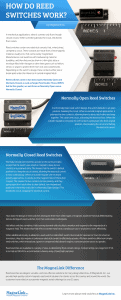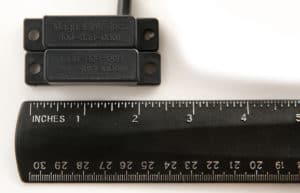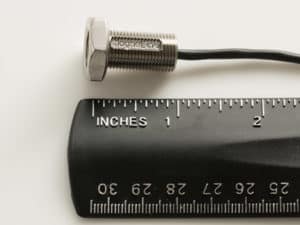A Design Guide for Reed Switches
If you’ve ever used a laptop or a flip phone, you may have wondered how the screen goes dormant once you close the device. Or maybe you’re curious about why your tablet screen turns on every time you open its protective cover. At the heart of these functions is an ingenious device called a reed switch.
What is a reed switch? Reed switches open and close electrical circuits when subjected to magnetic fields. For example, laptops usually have magnets at the top of the screen and the bottom of the keyboard; when the laptop is open, the magnets are far apart from each other, but when it closes, the magnets connect, interrupting the electrical circuit powering the laptop and causing it to enter sleep mode.
Reed switches appear in a wide range of applications, ranging from pacemakers to automotive exhaust sensors to toy lightsabers. Below, we’ve outlined the technology involved in building reed switches, as well as some of their most common applications.
What Is a Reed Switch?
A reed switch is a type of electrical switch with a magnetic-based actuation method. It contains two or three thin and flexible metal wires or blades (i.e., reeds) that are either touching or positioned a few microns apart within a hermetically sealed glass housing. The reeds serve as the switch’s contacts. When the switch is brought in close proximity to a magnetic field, the contacts either move apart or together, depending on whether the switch has a normally closed or normally open design.
The idea for reed switches was first proposed by Leningrad Electrotechnical University professor V. Kovalenkov in 1922. In 1936, Walter B. Elwood of Bell Laboratories designed the first reed switch. By 1938, experimental reed switches were integrated into coaxial cables to switch the cable’s center conductor. In 1940, the first reed switches became available to the public. Today, reed switches find application in many devices and systems, such as mobile phones, industrial equipment, automotive systems, and computers.
How Do Reed Switches Work?
In mechanical applications, electric currents only flow through closed circuits. When something breaks the circuit, the electric current flow ceases.
Reed switches contain two electrical contacts that, when joined, complete a circuit. These contacts are made from a ferromagnetic material, usually iron, that can be easily magnetized. Manufacturers coat switches with hardwearing metal for durability, and then they encase them in a thin glass tube or envelope filled with nitrogen or other inert gases such as helium, xenon, or argon to protect them from rust and contaminants. Depending on the switch’s design, these contacts either join or break apartunder the influence of outside magnet fields.
Reed switches come in two basic types: Normally Open and Normally Closed.
Normally Open Reed Switches
In a Normally Open reed switch design, the switch defaults to an open position, breaking the circuit. When an outside magnet approaches, it polarizes the two contacts, allowing them to attract each other and snap together. This closes the circuit, activating the electrical flow. When the outside magnet is removed, the stiff contacts spring back to their original position, thus breaking the circuit and halting the electrical current.
Normally Closed Reed Switches
Normally Closed reed switches operate on the same principle, except that the switch uses a built-in magnet to keep its two contacts in a polarized state. This means that the switch’s default position is to keep the circuit closed, allowing the electrical current to flow continuously. When an outside magnet with reversed polarity approaches, it cancels out the magnetic field of the built-in magnet. This causes the two contacts to lose polarity, and they spring apart from each other to their default, non-magnetized positions (where they would be in a Normally Open design). This breaks the circuit, stopping the electrical current.
How does the design of reed switches distinguish them from other types of magnetic switches? Several differentiating factors distinguish reed switches from their solid-state counterparts.
Hall effect switches combine a Hall-sensing element with circuitry to monitor and respond to the magnitude of a magnetic field. This means that Hall effect switches must have a continuous source of power to work effectively.
When additional circuitry is added to a reed switch or Hall effect switch, like triode AC devices (or Triacs for short) or transistors, they also require a continuous electrical current to effectively operate. All these switches differ from simple reed switches, which instead are a passive component that doesn’t require a constant power source to operate.
Reed switches are available in a variety of sizes as denoted by their contact ratings. Contact ratings can range from 3 VA to as high as 100 VA to accommodate a diverse array of switched load sizes.
Benefits of Using Reed Switches
Reed switches use much less power than other electronic switch alternatives. Their simple design also makes it much easier to test them out of circuit.
Reed switches come with a host of additional benefits, such as:
 Reliability and durability
Reliability and durability
Reed switches’ straightforward designs mean that they malfunction less often than other circuits, and their protective casings ensure that they can function in a variety of environments. These factors mean that reed switches can operate effectively for decades. Because of this, they’re frequently employed in digital on/off applications like door-closure detectors. A reed switch can have a life spanning tens of millions of switching cycles.
Precision in magnetic sensitivity
Reed switches’ magnetic sensitivity switch points offer higher levels of precision compared with solid-state sensors. This makes reed switches the optimal choice for applications that operate in highly variable environments.
Simple customization
Solid-state switches generally come in one-size-fits-all formats. In contrast, due to the inherent simplicity of their design, you can easily customize reed switches to fit the specifications of each end product.
Reed Switch Design Guide
Reed Switches and Application Fit
When implementing reed switches, engineers should consider the end product’s design requirements. Below are some of the most crucial factors influencing reed switch design.
 Electrical requirements
Electrical requirements
Engineers should determine the maximum switching current, voltage, and power that reed switch contacts can withstand. Contact arcing, or electrical discharge that crosses the gap between separated contacts, can damage the switching components and cause metal transfer, reducing the switch’s life span.
Engineers should also consider whether the reed switch will operate under AC or DC loads, what the minimum switching power will be, and whether the reed switch will fulfill its life expectancy under projected electrical loads.
Environmental factors
Reed switches can operate in a variety of settings. However, it’s important to determine the likely environment for end product use and select the proper switches for the design accordingly.
Reed switches are most susceptible to shock and vibration along the axis on which the switching components move. If excessive mechanical shock is expected to occur regularly when the switch is put into use, care should be taken to choose an appropriately sized reed switch that can best hold up to expected impact. In extreme cases, it may be better to consider using a Hall effect switch as it does not employ any mechanical contacts in its solid-state design.
Engineers should carefully consider the possibility of contact with or influence from outside magnetic fields or ferrous materials. For example, will nearby coils, motors, or batteries disrupt the switch’s magnetic field? If so, this could lead to unpredictable behavior, and steps should be taken to remove any of these stray magnetic fields from the area where the switch is in use.
Life Expectancy of Reed Switches
Compared to other types of switches, the life expectancy for reed switches is considerably longer. Since the contacts experience a relatively small range of mechanical motion, they rarely succumb to material fatigue.
Operating voltage is the main factor that affects the overall lifespan of a reed switch. Most reed switches are engineered for use in relatively low currents.
Other factors that might affect life expectancy include:
- DC vs. AC loads
- Contact arcing
- Vibration and shock
- Magnetic interference from other sources
The MagneLink Difference
Reed switches are elegant, versatile, and cost-effective solutions for many design dilemmas. At MagneLink, Inc., we provide high-quality custom magnetic reed switch solutions for clients across the country and around the world. Our customers have relied on our premier magnetic switch offerings for over 30 years.
If you’d like to learn more about our reed switch selection, contact us today. Once you experience the MagneLink difference, we’re sure that you won’t want to go anywhere else.


 Reliability and durability
Reliability and durability Electrical requirements
Electrical requirements